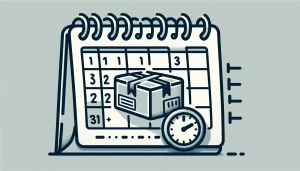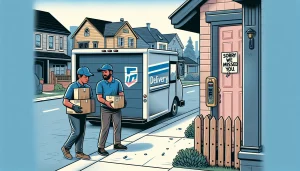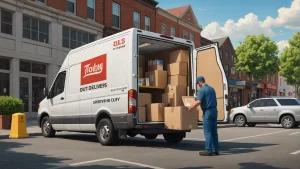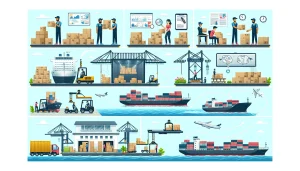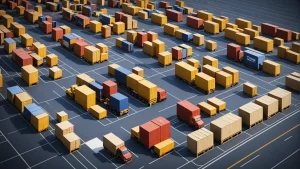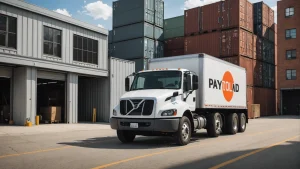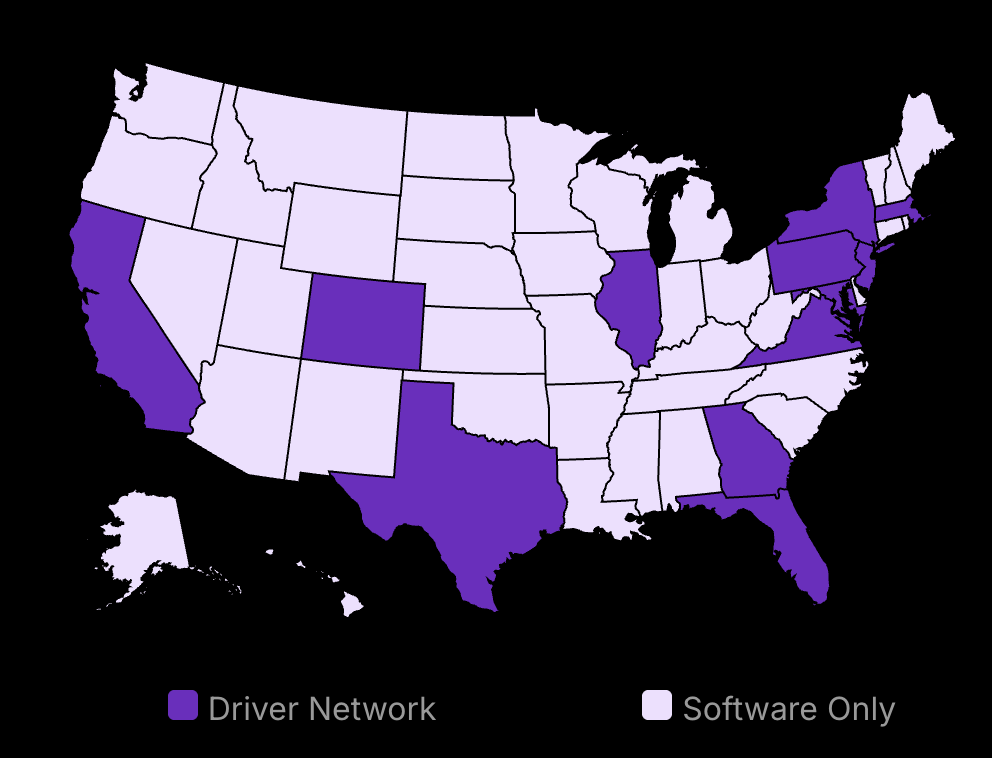In 2025, understanding the intricacies of shipping statuses like ‘dispatched from sorting center’ can make or break your e-commerce business.
In today’s fast-paced, customer-centric world, efficiently navigating the complex maze of order fulfillment is no longer optional – it’s essential.
As a business owner, you need to know exactly what happens when a package is dispatched from a sorting center and how it impacts your customers’ experience.
Get this right, and you’ll foster loyal, satisfied customers who keep coming back for more.
In this article, we’ll dive deep into the 12 key things you need to know about ‘dispatched from sorting center’ to optimize your shipping process, manage customer expectations, and ultimately, boost your bottom line.

Earn $1,200+/week delivering for local businesses
Driver benefits:
- Steady local business routes
- Weekly pay + tips
- Dedicated support team
- Flexible scheduling
Explanation of Dispatched from Sorting Center in Ecommerce Order Fulfillment
When a customer places an order on an e-commerce platform, the seller prepares the package and hands it over to a shipping carrier. The carrier then transports the package to a sorting center, which is a large facility designed to efficiently process and route packages to their final destinations.
Once the package arrives at the sorting center, it goes through a series of automated sorting processes. These processes involve:
Each package is scanned, and its tracking information is updated in the carrier’s system. This allows both the business and the customer to monitor the progress and arrival of the shipment.
Based on the package’s destination country, it is sorted into the appropriate bin or conveyor belt. This ensures that the package is directed towards the correct outbound truck or plane for its arrival on the next leg of its journey.
When the sorting process is complete, and the package is loaded onto the outbound vehicle, its tracking status is updated to ‘dispatched from sorting center.’ This means that the package has left the sorting facility and is en route to the sender or next stop in the shipping network, which could be another sorting center or the final delivery destination. Discover the nuances of the ‘Dispatched for Delivery’ stage and what it means as your parcel inches closer to its final destination. Decode this vital step in the journey of your online orders.
If you’re considering ways to enhance your shipping efficiency, you might want to explore how a reliable same-day delivery service in Chicago can significantly benefit your business by meeting urgent customer demands and improving satisfaction levels.
Significance of ‘Dispatched from Sorting Center’ for Businesses and Customers
For business owners, seeing the ‘dispatched from sorting center’ status update is a positive sign. It indicates that the order has been successfully processed by the shipping carrier and is moving through the company’s logistics network in the regional clusters. This information can be relayed to the contact or the customer, reassuring them that their order is on its way. As you think about optimizing your shipping processes, consider partnering with services that enhance delivery speed. For instance, Metrobi offers a tailored approach to logistics with their unique Boston same-day delivery options. This can set your business apart from competitors, ensuring quicker turnaround for local customers and boosting overall satisfaction.
However, it’s essential to manage customer expectations about the delivery process at this stage. ‘Dispatched from sorting center’ does not necessarily mean that the package will arrive at the customer’s doorstep immediately. The package leaves actual delivery date depends on factors such as: For customers seeking rapid fulfillment, exploring a reliable same-day delivery option can be beneficial. If your business operates in the New York City area, consider looking into our reliable New York City same-day delivery service to effectively meet urgent shipping needs and enhance customer satisfaction.
-
Distance between the sorting center and the delivery address
-
Shipping method chosen (e.g., standard, expedited, or overnight)
-
Potential delays due to weather, traffic, or other unforeseen circumstances
Businesses should communicate clearly with customers about the estimated delivery timeframes and provide regular updates as the package progresses through the shipping network. This transparency helps build trust and reduces the likelihood of customer inquiries or complaints.
The Role of Sorting Centers in the Shipping Process
What Are Sorting Centers and How Do They Function?
Sorting centers, also known as distribution centers or hubs, are large facilities where packages and parcels are sorted and routed to their final destinations. These centers play a vital role in the shipping process, streamlining the flow of packages and ensuring they reach their intended recipients promptly.
When a package arrives at a sorting distribution center, it undergoes a series of automated and manual processes to determine its next destination. The package is scanned, and the information is fed into a complex system that determines the most efficient route to its final destination based on factors. Discover how the estimated time frame for delivery influences the scheduling of when your parcel will arrive.
Package Processing and Routing at Sorting Centers
Once a package has been sorted, it is prepared for the next leg of its journey. Sorting centers are strategically located near major transportation hubs to facilitate the efficient transfer of packages to the appropriate vehicles.
Depending on the package’s destination and the shipping method chosen by the carrier facility sender, it may be transported by plane, truck, or train. Sorting centers work closely with various carriers to ensure that packages are loaded onto the correct vehicles and dispatched promptly.
For example, packages destined for international locations may be loaded onto cargo planes, while those traveling shorter distances may be transported by truck. The sorting center’s staff carefully coordinates with carriers to optimize transportation routes and minimize delays.
The Importance of Efficient Sorting Centers for Businesses
For businesses that rely on shipping to deliver their products to customers, the efficiency of sorting centers is paramount. When sorting centers operate smoothly, packages are processed and dispatched quickly, reducing the overall transit time and increasing customer satisfaction.
Conversely, delays or errors at sorting centers can have a ripple effect on the entire shipping process, leading to longer delivery times, frustrated customers, and potentially lost business. Therefore, businesses must partner with reliable carriers that have a proven track record of maintaining efficient sorting center operations.
A study by the National Retail Federation found that 71% of consumers consider fast and reliable shipping to be a key factor in their online shopping decisions, highlighting the importance of efficient sorting centers and warehouses for businesses.
Implications of ‘Dispatched from Sorting Center’ Status
-
Understand what ‘Dispatched from Sorting Center’ means for your package’s journey
-
Learn the typical time frames for delivery once a package reaches this status
-
Discover factors that can influence the speed of delivery after dispatch
What ‘Dispatched from Sorting Center’ Means for Your Shipment’s Progress
When a package is marked as ‘Dispatched from Sorting Center’, it indicates that the item has been processed at the regional sorting center or facility and is now en route to the next destination in the next steps of its journey. This is a crucial milestone in the shipping process, as it signifies that the package is one step closer to reaching the customer. Dive into the significance of the phrase ‘Dispatched from Sorting Center’ and understand its vital role in the journey of your parcel towards its final destination.
Sorting centers play a vital role in the efficient processing and distribution of all parcels and packages. These facilities are equipped with advanced technology and staffed by skilled personnel who ensure that each item is correctly sorted and routed to its intended destination. The sorting process typically involves:
-
Receiving incoming packages from various sources
-
Scanning and verifying package information
-
Sorting packages based on destination and shipping method
-
Preparing packages for dispatch to the next location
Once a package has been processed at the sorting center and is ready for delivery truck the next leg of its journey, its status is updated to ‘Dispatched from Sorting Center’.
Estimated Time Frame for Delivery After Dispatch
The time it takes for a package to be delivered after being dispatched from the sorting center facility can vary depending on several factors. However, in most cases, customers can expect their package to arrive within 1-5 business days after reaching this status. Curious about when your package will arrive? Getting to grips with the Anticipated Delivery Time can provide insights into when your order will likely land on your doorstep.
Factors Influencing Delivery Time
Several key factors can impact the delivery time once a package has been dispatched from the sorting center directly to the processing center:
-
Shipping method: The chosen shipping option (e.g., standard, expedited, or overnight) will significantly influence the delivery time.
-
Distance: The distance between the sorting center and the package’s final destination can affect the time it takes for the item to be delivered.
-
Transportation network: The efficiency and reliability of the transportation network used by the shipping carrier can impact delivery times.
-
Weather conditions: Adverse weather events, such as storms or natural disasters, can cause delays in package delivery.
-
Customs processing (for international shipments): International packages may require additional time for customs clearance, which can extend the overall delivery time.
The Importance of Tracking and Communication
Once a package has been dispatched from the sorting center, businesses must keep track of its progress and communicate any updates to their customers through automated emails that provide timely tracking information and delivery status. This can be achieved by:
-
Providing tracking numbers: Ensure that customers receive a tracking number for their package, allowing them to monitor its progress independently.
-
Sending regular updates: Keep customers informed about the status of their package through automated emails or SMS notifications.
-
Offering customer support: Make sure that customers can easily reach out to your support team if they have any questions or concerns about their shipment.
For businesses handling global customer support, a virtual phone system offers the best tool for optimized and cost-efficient communication. By keeping customers informed and providing transparent communication, businesses can enhance the overall shipping experience and build trust with their clients.
Understanding the E-commerce Order Fulfillment Process
The Path of an Online Order
When a customer places an order on an e-commerce website or digital catalog, it sets in motion a series of intricate steps that ultimately lead to the product arriving at their doorstep. This process, known as order fulfillment, involves multiple stages and stakeholders working together seamlessly.
The first step is order processing, where the customer’s order details are received and verified by the e-commerce company’s system. This includes checking inventory availability, payment processing, and generating a pick list for the warehouse staff. Efficient order processing is crucial to ensure timely fulfillment and avoid delays—especially when paired with optimized Magento hosting that supports fast data processing, seamless inventory updates, and real-time order tracking.
Order Picking and Packing
Once the order is processed, it moves to the order-picking stage. Warehouse staff locate and retrieve the ordered items from the shelves using the pick list generated by the system. Efficient warehouse layout and organization are essential to minimize picking time and errors.
After picking, the items are packed securely for shipping. Packaging plays a crucial role in onward shipping and in ensuring the products reach the customer in perfect condition. E-commerce businesses often use specialized packaging materials and techniques to protect items during transit.
Accurate inventory management, supported by bookkeeping software, is the backbone of successful order fulfillment. Real-time inventory tracking using barcode scanning and RFID technology helps maintain inventory accuracy and boost warehouse KPIs.
According to a 2022 report by the National Retail Federation, inventory accuracy rates of 95% or higher are considered best-in-class. However, achieving this level of accuracy requires continuous monitoring and optimization of inventory processes.
Shipping and Delivery
The final stage of order fulfillment is shipping the packaged order to the customer. E-commerce businesses partner with shipping carriers like FedEx, UPS, or DHL to transport packages to their destinations. Efficient shipping management involves selecting the right carrier, negotiating rates, and tracking shipments.
The rise of same-day and next-day delivery has raised customer expectations for fast and reliable shipping. According to a 2023 consumer survey by PWC, 41% of online shoppers are willing to pay extra for same-day delivery. Meeting these expectations requires a well-orchestrated shipping strategy and close collaboration with carriers.
Efficient order fulfillment is an ongoing process that requires continuous monitoring, analysis, and improvement. E-commerce businesses should regularly review their fulfillment metrics, such as order accuracy, picking speed, and shipping times, to identify areas for optimization.
Implementing lean principles, such as 5S (Sort, Set in Order, Shine, Standardize, Sustain), can help streamline warehouse operations and reduce waste. Regularly gathering feedback from customers and staff can also provide valuable insights for improvement.
Choosing the Right Shipping Carriers and Methods
-
Selecting the optimal shipping carriers and methods is crucial for efficient order fulfillment
-
Factors like cost, speed, reliability, and customer preferences should guide decision-making
-
Understanding the strengths and limitations of each carrier can help businesses make informed choices
Overview of Popular Shipping Carriers and Their Services
In the world of e-commerce shipping, there are several major carriers that businesses rely on to deliver their products to customers. Each carrier offers a range of services tailored to different needs and priorities.
United States Postal Service (USPS)
The USPS is a popular choice for many businesses, particularly those shipping lightweight packages. They offer a variety of services, including First-Class Mail, Priority Mail, and Priority Mail Express. The USPS is known for its extensive domestic coverage and affordable rates, making it an attractive option for small businesses and startups.
However, the USPS does have some limitations. They may not be the fastest option for time-sensitive shipments, and their tracking capabilities may not be as robust as some other carriers. Additionally, the USPS has faced challenges with delays and service disruptions in recent years, particularly during peak shipping seasons.
FedEx and UPS
FedEx and UPS are two of the most well-known private shipping carriers, offering a wide range of domestic and international shipping services. Both carriers have extensive networks and advanced tracking capabilities, making them popular choices for businesses that prioritize speed and reliability.
FedEx offers services like FedEx Ground, FedEx Express, and FedEx Freight, catering to different package sizes and delivery timeframes. They also provide specialized services for healthcare, e-commerce, and other industries.
Similarly, UPS offers services such as UPS Ground, UPS Next Day Air, and UPS Worldwide Express. They have a strong reputation for on-time delivery and offer additional services like UPS My Choice, which allows customers to contact them to manage their deliveries and provide delivery instructions.
While FedEx and UPS are known for their reliability and speed, they may be more expensive than other options, particularly for small businesses with tight shipping budgets.
Factors to Consider When Selecting Shipping Methods
Choosing the right shipping method involves weighing several key factors to ensure that you’re meeting your business’s needs and your customers’ expectations.
Cost
Shipping costs can have a significant impact on your bottom line, so it’s essential to consider the pricing structures of different carriers and services. Some carriers offer discounted rates for high-volume shippers, while others may have more affordable options for lightweight packages.
Speed and Reliability
The speed and reliability of your chosen shipping service and method can directly impact customer satisfaction. If you’re selling products that are time-sensitive or require expedited shipping, you’ll want to choose a carrier and service that can consistently meet those demands.
Consider the average transit times for different services and look at the carrier’s on-time delivery record. You may also want to factor in the carrier’s ability to handle peak shipping volumes, such as during the holiday season.
Tracking and Insurance
Accurate tracking is essential for both businesses and customers, as it allows for real-time updates on a package’s location and estimated delivery date and time. Look for carriers that offer robust tracking capabilities and provide easy access to tracking information for both you and your customers.
Additionally, consider the insurance options available through each carrier. Shipping insurance can provide peace of mind and financial protection in case a package is lost, damaged, or stolen in transit.
Difference Between ‘Shipped’ and ‘Dispatched’ Statuses in the Delivery Process
-
Understanding the nuances between ‘shipped’ and ‘dispatched’ can help businesses better manage customer expectations
-
Knowing when a package is truly on its way versus when it’s ready to go is key for accurate order tracking
-
Differentiating these statuses allows for more precise communication with customers and internal teams
Defining ‘Shipped’ and ‘Dispatched’ in Order Fulfillment
In the world of e-commerce and order fulfillment, for instance, the terms ‘shipped’ and ‘dispatched’ are often used interchangeably, but they refer to different stages in the shipping process.
‘Dispatched’ Status Explained
When an order is marked as ‘dispatched’, it means that the package has been processed, packaged, labeled, stamped, and is ready to be handed off to the shipping carrier. At this point, the order or parcel has left the seller’s hands and is queued for pickup by the carrier. If your order shows ‘dispatched’ but later encounters an unsuccessful delivery attempt, learn what may have caused this issue and how you can ensure successful delivery in the future.
However, ‘dispatched’ doesn’t always mean the package is physically on a truck or plane. There may still be only a few hours of delay between dispatch and the carrier taking possession of the package, especially if there are limited pickup times or the order was processed after the cutoff for the day.
‘Shipped’ Status Explained
In contrast, an order is typically marked as ‘shipped’ once the carrier has physically taken possession of the package. This is when the package begins its journey to the customer.
At this point, the carrier will scan the package and update the tracking number and information to reflect that it’s now en route. The ‘shipped’ package status now is a stronger signal to the customer that their order is truly on the move.
Why the Distinction Matters for Businesses
While the difference between ‘dispatched’ and ‘shipped’ may seem minor, it can have a big impact on customer communication and expectations.
If a business marks an order as ‘shipped’ when it’s only been dispatched, the customer may expect to see movement on the tracking information and be disappointed when there are delays.
On the flip side, if an order is marked as ‘dispatched’ for too long without updating to ‘shipped’, the customer may worry that there’s a problem with their order. Clear communication about when an order is expected to ship out can alleviate these concerns.
The distinction is also important for a business’s operations. Knowing exactly how many orders are truly shipped versus just dispatched can help with inventory management, cash flow predictions, and identifying potential bottlenecks in the fulfillment process.
For example, if there’s regularly a long delay between orders being dispatched and shipped, it could indicate an issue with the carrier pickup schedule that needs to be addressed.
Best Practices for Using ‘Shipped’ and ‘Dispatched’ Statuses
To make the most of these status distinctions, businesses should:
-
Clearly define when an order will be marked as ‘dispatched’ vs ‘shipped’ and communicate this to customers, perhaps in the order confirmation email or FAQ.
-
If possible, include an estimated ship date in addition to the dispatch date to set expectations.
-
Monitor the average time between dispatch and ship and work to minimize it. The faster an order is in the carrier’s hands, the better.
-
Consider using more granular statuses like ‘label created’, ‘processing’, ‘ready for pickup’, etc. to give customers more insight into their order status.
The bottom line is that while ‘dispatched’ and ‘shipped’ are often used synonymously, they signal different things to customers. Using them strategically and communicating clearly can improve the overall customer experience and streamline internal operations.
Wrapping Up: Navigating the Shipping Journey with Confidence
As a business owner in 2025, understanding the intricacies of the shipping process is crucial for success. ‘Dispatched from the sorting center’ is a key milestone that signals your package’s progress through the complex network of logistics and delivery.
By optimizing your order fulfillment process, choosing the right shipping carriers, and leveraging tracking information, you can ensure a smooth and satisfying experience for your customers. Remember, clear communication and proactive management of expectations are essential for building trust and loyalty.
Are you ready to take your e-commerce business to the next level? Implement these strategies and watch your customer satisfaction soar. Stay ahead of the game by continuously monitoring your shipping performance and adapting to the ever-evolving landscape of e-commerce.





